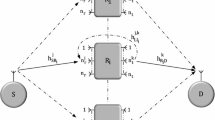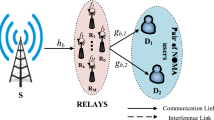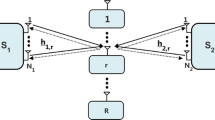Abstract
We analyze the outage performance of relay selection in two-way full-duplex amplify-and-forward cooperative systems in the presence of residual loop-interference (LI) over Nakagami-m fading channels. In the proposed system, a relay node is selected according to max-min policy and the physical-layer-network-coding technique is applied for two-way transmission. By using end-to-end signal-to-interference-plus-noise-ratio, a new exact outage probability expression is derived in a single-integral form. The numerical and Monte-Carlo simulation results verify the analysis. Moreover, lower-bound and asymptotic expressions for the outage probability are obtained in closed-form. The numerical results reveal that the max-min selection policy provides a significant performance improvement for two-way full-duplex relaying. We observe that the outage performance can be enhanced as long as either the number of relay nodes, the transmit power, or the efficiency of the LI cancellation process increases.






Similar content being viewed by others
References
Laneman JN, Tse DNC, Wornell GW (2004) Cooperative diversity in wireless networks: Efficient protocols and outage behavior. IEEE Trans Inf Theory 50(12):3062–3080. https://doi.org/10.1109/TIT.2004.838089
Zhao Q, Li H (2006) Distributed modulation for cooperative wireless communications. In: 2006 40th annual conference on information sciences and systems, pp 1068–1072. https://doi.org/10.1109/CISS.2006.286624
Louie RHY, Li Y, Vucetic B (2010) Practical physical layer network coding for two-way relay channels: performance analysis and comparison. IEEE Trans. Wireless Commun 9(2):764–777. https://doi.org/10.1109/TWC.2010.02.090314
Riihonen T, Werner S, Wichman R (2009) Optimized gain control for single-frequency relaying with loop interference. IEEE Trans Wireless Commun 8(6):2801–2806. https://doi.org/10.1109/TWC.2009.080542
Hong S, Brand J, Choi J I, Jain M, Mehlman J, Katti S, Levis P (2014) Applications of self-interference cancellation in 5G and beyond. IEEE Commun Mag 52(2):114–121. https://doi.org/10.1109/MCOM.2014.6736751
Duarte M, Dick C, Sabharwal A (2012) Experiment-driven characterization of full-duplex wireless systems. IEEE Trans Wireless Commun 11(12):4296–4307. https://doi.org/10.1109/TWC.2012.102612.111278
Krikidis I, Suraweera HA, Smith PJ, Yuen C (2012) Full-duplex relay selection for amplify-and-forward cooperative networks. IEEE Trans Wireless Commun 11(12):4381–4393. https://doi.org/10.1109/TWC.2012.101912.111944
Choi D, Lee JH (2014) Outage probability of two-way full-duplex relaying with imperfect channel state information. IEEE Commun Lett 18(6):933–936. https://doi.org/10.1109/LCOMM.2014.2320940
Cui H, Ma M, Song L, Jiao B (2014) Relay selection for two-way full duplex relay networks with amplify-and-forward protocol. IEEE Trans Wireless Commun 13(7):3768–3777. https://doi.org/10.1109/TWC.2014.2322607
Li Y, Wang T, Zhao Z, Peng M, Wang W (2015) Relay mode selection and power allocation for hybrid one-way/two-way half-duplex/full-duplex relaying. IEEE Commun Lett 19(7):1217–1220. https://doi.org/10.1109/LCOMM.2015.2433260
Li Y, Li N, Peng M, Wang W (2016) Relay power control for two-way full-duplex amplify-and-forward relay networks. IEEE Signal Process Lett 23(2):292–296. https://doi.org/10.1109/LSP.2016.2517020
Zhang Z, Ma Z, Xiao M, Karagiannidis GK, Ding Z, Fan P (2016) Two-timeslot two-way full-duplex relaying for 5G wireless communication networks. IEEE Trans Commun 64(7):2873–2887. https://doi.org/10.1109/TCOMM.2016.2574845
Zhang Z, Chen Z, Shen M, Xia B (2016) Spectral and energy efficiency of multipair two-way full-duplex relay systems with massive MIMO. IEEE J Select Areas Commun 34(4):848–863. https://doi.org/10.1109/JSAC.2016.2544458
Shim Y, Choi W, Park H (2016) Beamforming design for full-duplex two-way amplify-and-forward MIMO relay. IEEE Trans Wireless Commun PP(99):1–1. https://doi.org/10.1109/TWC.2016.2587768
Do TP, Le TVT (2015) Power allocation and performance comparison of full duplex dual hop relaying protocols. IEEE Commun Lett 19(5):791–794. https://doi.org/10.1109/LCOMM.2015.2414432
Gradshteyn IS, Ryzhik IM (2007) Table of integrals, series, and products, 7th edn. Elsevier/Academic Press, Amsterdam
Kumbhani B, Kshetrimayum RS (2014) Outage probability analysis of spatial modulation systems with antenna selection. Electron Lett 50(2):125–126. https://doi.org/10.1049/el.2013.3466
Author information
Authors and Affiliations
Corresponding author
Appendix: Proof of Eq. 10
Appendix: Proof of Eq. 10
By using [9, Eq. (35)], the CDF of γ i, b can be given by
where \({\bar F}_{{\gamma _{i,c}}}\left (\cdot \right )=1-F_{{\gamma _{i,c}}}\left (\cdot \right )\). By substituting the PDF and CDF expressions of γ i, c given in Section 2.1, the above expression is rewritten as
where Γ(⋅,⋅) is the upper incomplete Gamma function [16, Eq. (8.350.2)]. For the integer values of m, by using binomial expansion and [16, Eq. (8.352.4)],
can be obtained. For the solution of the first integration I 3, we need to use multinomial coefficients as in [17, Eq. (7)] and [16, Eq. (3.351.1)]. Then, I 3 is found as
where 𝜃 1 = (2k + 1)(m − 1) and \({\Phi }_{t}^{2k+1}\) is the coefficient of (μx)t in the expansion of
The other expression I 4 is composed of double-integrals. The inner integration inside I 4 can be found by following the same steps applied to I 3 and it is given by
where 𝜃 2 = 2k(m − 1) and \({\Phi }_{t}^{2k}\) is also the coefficient of (μy)t in the expansion of
By applying both [16, Eq. (8.352.6)] and [16, Eq. (3.351.1)], respectively, I 4 can be easily found in a closed-form as
Finally, the CDF of γ i, b given in Eq. 10 can be obtained by substituting (42) and (46) into (41).
Rights and permissions
About this article
Cite this article
Koç, A., Altunbaş, İ. & Yongaçoğlu, A. Relay selection in two-way full-duplex relay networks over Nakagami-m fading channels. Ann. Telecommun. 72, 731–742 (2017). https://doi.org/10.1007/s12243-017-0603-6
Received:
Accepted:
Published:
Issue Date:
DOI: https://doi.org/10.1007/s12243-017-0603-6




